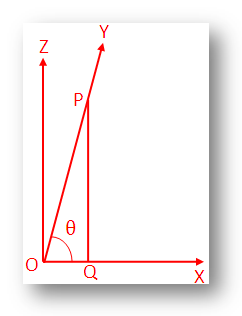Subscribe to our ▶️ YouTube channel 🔴 for the latest videos, updates, and tips.
Trigonometrical Ratios of 90°
How to Find the Trigonometrical Ratios of 90°?
Let a rotating line \(\overrightarrow{OX}\) rotates about O in the anti-clockwise sense and starting from its initial position \(\overrightarrow{OX}\) traces out ∠XOY = θ where θ is very nearly equal to 90°.
Let \(\overrightarrow{OX}\) ⊥ \(\overrightarrow{OZ}\) therefore, ∠XOZ = 90°
Take a point P on \(\overrightarrow{OY}\) and draw \(\overline{PQ}\) perpendicular to \(\overline{OX}\).
Then,
Sin θ = \(\frac{\overline{PQ}}{\overline{OP}}\);
cos θ = \(\frac{\overline{OQ}}{\overline{OP}}\)
and tan θ =\(\frac{\overline{PQ}}{\overline{OQ}}\)
When θ is slowly approaches 90° and finally tends to 90° then,
(a) \(\overline{OQ}\) slowly decreases and finally tends to zero and
(b) the numerical difference between \(\overline{OP}\) and \(\overline{PQ}\) becomes very small and finally tends to zero.
Hence, in the Limit when θ → 90° then \(\overline{OQ}\) → 0 and \(\overline{PQ}\) → \(\overline{OP}\) . Therefore, we get
\(\lim_{θ \rightarrow 90°} \) sin θ
= \(\lim_{θ \rightarrow 90°}\frac{\overline{PQ}}{\overline{OP}} \)
= \(\frac{\overline{OP}}{\overline{OP}} \) [since, θ → 90° therefore, \(\overline{PQ}\) → \(\overline{OP}\) ].
= 1
Therefore sin 90° = 1
\(\lim_{θ \rightarrow 90°} \) cos θ
= \(\lim_{θ \rightarrow 90°}\frac{\overline{OQ}}{\overline{OP}} \)
= \(\frac{0}{\overline{OP}} \), [since, θ → 0° therefore, \(\overline{OQ}\) → 0].
= 0
Therefore cos 90° = 0
\(\lim_{θ \rightarrow 90°}\) tan θ
= \(\lim_{θ \rightarrow 90°}\frac{\overline{PQ}}{\overline{OQ}}\)
= \(\frac{\overline{OP}}{0}\) [since, θ → 0° \(\overline{OQ}\) → 0 and \(\overline{PQ}\) → \(\overline{OP}\)].
= undefined
Therefore tan 900 = undefined
Thus,
csc 90° = \(\frac{1}{sin 90°} \)
= \(\frac{1}{1} \), [since, sin 90° = 1]
= 1
sec 90° = \(\frac{1}{cos 90°} \)
= \(\frac{1}{0} \), [since, cos 90° = 0]
= undefined
cot 0° = \(\frac{ cos 90°}{ sin 90°} \)
= \(\frac{0}{1} \), [since, sin 900 = 1 and cos 90° = 0]
= 0
Trigonometrical Ratios of 90 degree are commonly called standard angles and the trigonometrical ratios of these angles are frequently used to solve particular angles.
● Trigonometric Functions
- Basic Trigonometric Ratios and Their Names
- Restrictions of Trigonometrical Ratios
- Reciprocal Relations of Trigonometric Ratios
- Quotient Relations of Trigonometric Ratios
- Limit of Trigonometric Ratios
- Trigonometrical Identity
- Problems on Trigonometric Identities
- Elimination of Trigonometric Ratios
- Eliminate Theta between the equations
- Problems on Eliminate Theta
- Trig Ratio Problems
- Proving Trigonometric Ratios
- Trig Ratios Proving Problems
- Verify Trigonometric Identities
- Trigonometrical Ratios of 0°
- Trigonometrical Ratios of 30°
- Trigonometrical Ratios of 45°
- Trigonometrical Ratios of 60°
- Trigonometrical Ratios of 90°
- Trigonometrical Ratios Table
- Problems on Trigonometric Ratio of Standard Angle
- Trigonometrical Ratios of Complementary Angles
- Rules of Trigonometric Signs
- Signs of Trigonometrical Ratios
- All Sin Tan Cos Rule
- Trigonometrical Ratios of (- θ)
- Trigonometrical Ratios of (90° + θ)
- Trigonometrical Ratios of (90° - θ)
- Trigonometrical Ratios of (180° + θ)
- Trigonometrical Ratios of (180° - θ)
- Trigonometrical Ratios of (270° + θ)
- Trigonometrical Ratios of (270° - θ)
- Trigonometrical Ratios of (360° + θ)
- Trigonometrical Ratios of (360° - θ)
- Trigonometrical Ratios of any Angle
- Trigonometrical Ratios of some Particular Angles
- Trigonometric Ratios of an Angle
- Trigonometric Functions of any Angles
- Problems on Trigonometric Ratios of an Angle
- Problems on Signs of Trigonometrical Ratios
11 and 12 Grade Math
From Trigonometrical Ratios of 90° to HOME PAGE
Didn't find what you were looking for? Or want to know more information about Math Only Math. Use this Google Search to find what you need.



New! Comments
Have your say about what you just read! Leave me a comment in the box below. Ask a Question or Answer a Question.